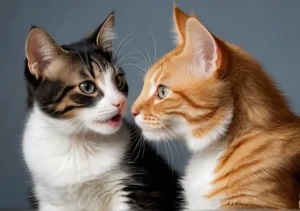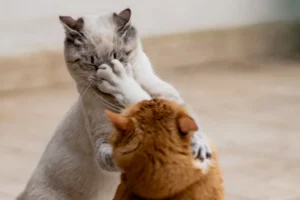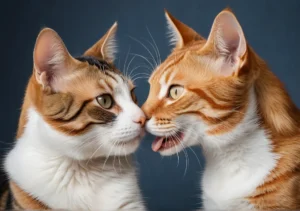Have you been wondering why your beloved feline friends seem to be constantly at odds with each other? The constant hissing, swatting, and chasing may have you feeling frustrated and concerned about their well-being. But fear not, there are reasons behind this behavior that can be understood and addressed.
Understanding Feline Behavior
Cats are known for their independent nature, but they also have strong instincts that can lead to conflicts in multi-cat households. One of the key reasons cats may fight is due to their natural territorial behavior. In the wild, cats establish and defend their territories to ensure access to resources like food, shelter, and mates.
When multiple cats share a home, they may each try to establish their own territory within the space, leading to tension and potential conflicts. Additionally, cats are solitary hunters by nature, so they may not always enjoy sharing resources with other felines.
To reduce fighting among your cats, provide plenty of vertical space, such as cat trees or shelves, for each cat to claim as their own. Creating a harmonious environment with separate feeding areas, litter boxes, and hiding spots can also help minimize territorial disputes.
Territory and Resources
Competition for territory, food, toys, and attention can be a significant trigger for fights between cats. When resources are limited, cats may feel the need to assert dominance or guard the available resources, leading to conflicts with other cats in the household.
To prevent resource-related conflicts, make sure there are enough resources to go around. A good rule of thumb is to have one litter box per cat, plus one extra, and multiple feeding stations to prevent competition during mealtimes.
Additionally, providing enrichment in the form of interactive toys, scratching posts, and puzzle feeders can help keep your cats mentally stimulated and reduce the likelihood of conflicts over resources. Regular play sessions and individual attention can also help each cat feel secure in their place within the household.
By understanding the natural behaviors and instincts of your feline companions, you can better address the root causes of conflicts and create a harmonious environment where your cats can coexist peacefully. Remember, every cat is unique, so it may take some trial and error to find the right balance for your furry family members.
Social Hierarchy
Cats are naturally territorial animals, and within a multi-cat household, establishing a social hierarchy is crucial. In a group of cats, there will inevitably be dominant and submissive individuals. Dominant cats may assert their authority through aggressive behaviors like swatting, hissing, or blocking access to resources. Submissive cats, on the other hand, may try to avoid conflict by retreating or displaying appeasement behaviors.
To minimize conflicts stemming from social hierarchy issues, make sure to provide multiple resources like food bowls, water dishes, litter boxes, and resting spots in different areas of your home. This can help prevent competition and reduce the likelihood of confrontations between your cats. Additionally, offering vertical spaces like cat trees or shelves can give your feline friends a chance to establish their own territories and avoid potential clashes over space.
Unique insight: Implement a gradual reintroduction process if your cats have been fighting frequently. Separate them initially and then slowly reintroduce them using positive reinforcement techniques like treats or playtime together in a controlled environment. This can help rebuild their relationship and reduce tension between them over time.
Stress and Anxiety
Stress and anxiety are common triggers for cat fights. Changes in routine, new environments, loud noises, or the addition of a new pet or family member can all contribute to a tense atmosphere for your cats. When cats feel stressed or anxious, they may exhibit aggressive behaviors as a way to cope with their emotions.
To reduce stress levels in your cats, try to maintain a consistent daily routine and create a calm environment in your home. Provide plenty of hiding spots, cozy resting areas, and interactive toys to keep your cats mentally stimulated. Consider using pheromone diffusers or calming supplements recommended by your veterinarian to help alleviate anxiety in your feline companions.
Remember, understanding the root causes of your cats’ fights is essential in addressing the issue effectively and promoting a harmonious relationship between them. By implementing these strategies, you can create a peaceful coexistence for your furry friends and foster a more positive environment in your home.
Health Issues
If you’re wondering, “why are my cats always fighting?” – it could be down to health issues. When our furry friends aren’t feeling their best, they can get a little cranky. Pain or discomfort from conditions like urinary tract infections or dental problems can make a kitty lash out at their feline pals. So, if you notice an uptick in squabbles, it might be wise to schedule a visit to the vet for a check-up. Remember, a healthy cat is a happy cat!
Introducing New Cats
Thinking of expanding your fur family? Bringing in a new cat can be an exciting time, but it can also lead to lots of hissing and scratching matches if not done right. To avoid turning your home into a wrestling ring, make sure to take it slow. Gradually introduce the new kitty to your current pets by swapping their scents using blankets or toys. This way, they can get familiar with each other without any territorial disputes.
Additional Unique Insight:
One key tip that can help reduce conflicts between your cats is to ensure they have enough space to call their own. Providing multiple vertical spaces like cat trees or shelves can give each cat a spot to retreat to when they need some alone time. Remember, even the most social kitties need their own space!
Providing Enrichment
Are your cats always fighting? One reason for this could be boredom. Cats are intelligent and active animals, and if they don’t have enough mental and physical stimulation, they may resort to fighting with each other. To prevent this, make sure to provide enrichment for your feline friends. This can include interactive toys, puzzle feeders, cat trees, scratching posts, and even designated playtime with you. By keeping your cats entertained and engaged, you can reduce their boredom and decrease the likelihood of conflicts.
Seeking Professional Help
If your cats’ fighting is becoming excessive or aggressive, it may be time to seek professional help. Consult with a veterinarian to rule out any underlying medical issues that could be causing the behavior. Additionally, consider working with an animal behaviorist who can assess the situation and provide strategies to manage conflicts between your cats. Remember, it’s important to address the root cause of the fighting to ensure a harmonious environment for both your pets.
Fun Fact: Cats Have Complex Communication Systems
Did you know that cats have intricate ways of communicating with each other? From body language to vocalizations and scent marking, these furry friends have a sophisticated system of conveying their emotions and intentions. Understanding these cues can shed light on why your cats might be fighting.
When cats fight, they may be trying to establish dominance or territory. Aggressive behavior could also stem from stress, fear, or a health issue. Observing their body language, such as flattened ears, dilated pupils, or raised fur, can give you clues about their state of mind. Additionally, paying attention to their vocalizations and scent markings can help decipher their communication patterns.
Next time you witness your cats engaging in a tussle, take a step back and analyze their behavior through the lens of their complex communication system. By tuning into their subtle cues, you may be able to intervene and prevent future conflicts.
- Body language: Watch out for tail flicking, hissing, or growling.
- Vocalizations: Pay attention to meowing, yowling, or any unusual sounds.
- Scent marking: Notice if your cats are rubbing their cheeks or spraying urine.
By honing in on these communication methods, you can gain valuable insights into your cats’ behavior and foster a more harmonious living environment for your furry companions.
Alex, a passionate animal lover, has experience in training and understanding animal behavior. As a proud pet parent to two dogs and three cats, he founded AnimalReport.net to share insights from animal experts and expand his knowledge of the animal kingdom.




